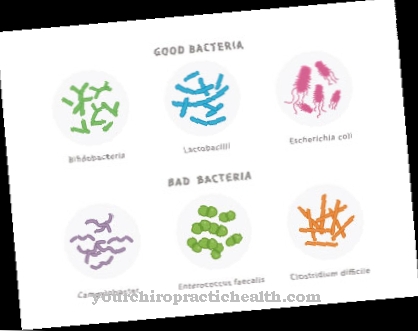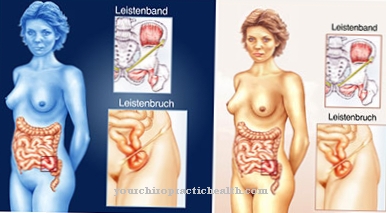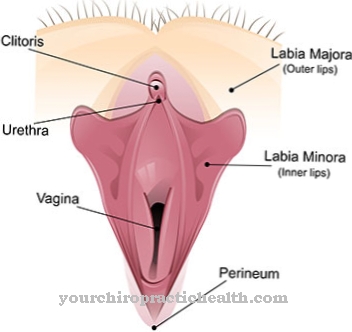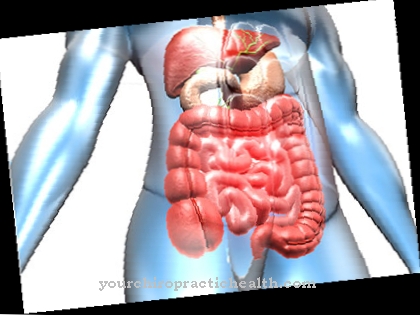At a Dysbacteria the natural bacterial flora in the intestines, oral cavity, on the skin or in the vagina is disturbed. Disturbances in the bacterial flora often lead to diseases that can affect the entire organism.
What is a dysbacteria?

© Bezvershenko - stock.adobe.com
Every higher organism lives in symbiosis with microorganisms. This symbiosis proves to be useful for the respective organism as well as for the bacterial flora.
The bacterial cultures are provided with the necessary nutrients and they provide vital bioactive substances such as B. Vitamin B12 by intestinal bacteria. It must be said that a corresponding bacterial flora always contains both pathogenic and beneficial bacteria.
In the healthy organism, however, the beneficial bacteria dominate over the potentially harmful ones. If this balance is shifted in favor of the harmful bacteria, one speaks of dysbacteria. Dysbacteria occur mainly in the intestines, vagina, and oral cavity.
causes
The causes of a dysbacteria are diverse. The basis for shifting the balance in the bacterial flora lies in the different requirements of the individual types of bacteria on the environment.
So z. B. the pH value, the oxygen content, the food supply, but also various poisons play a role in disadvantaging certain bacteria, but promoting others. A low pH value favors the occurrence of a dysbacteria in the intestine with the preference for coliform bacteria.
The changes in the milieu in the intestine are often triggered by poor nutrition, other illnesses or the administration of antibiotics. In addition to other diseases, incorrect oral and dental care often lead to dysbacteria in the oral cavity. In addition to frequent sexual intercourse, the causes of bacterial vaginosis are also excessive vaginal hygiene, antibiotics or foreign bodies.
You can find your medication here
➔ Medicines against flatulence and digestive problemsSymptoms, ailments & signs
The dysbacteria is usually associated with various ailments and symptoms in the stomach and intestines. Those affected suffer from severe digestive discomfort, which can lead to flatulence or constipation. In some cases, however, the dysbacteria also leads to diarrhea and significantly reduces the person's quality of life.
In many cases, those affected also suffer from abdominal pain or stomach ache, and it is not uncommon for nausea or vomiting to occur. Furthermore, without treatment, permanent digestive disorders occur, so that those affected suffer from deficiency symptoms. The body is also not properly detoxified, so in some cases the symptoms of poisoning can occur.
Often women suffer from complaints of the vagina with a dysbacteria, which can lead to the formation of fungi. This causes very unpleasant itching and reddening of the vagina. The itching can also occur in the anus and reduce the patient's quality of life. In many cases, those affected appear irritated by the permanent symptoms or suffer from psychological upset and depression.
course
Dysbacteria are often the cause of various diseases. A dysbacteria in the intestine, also known as dysbiosis, can cause systemic disorders in the body.
Some E. coli bacteria form toxins which initially cause digestive disorders in the intestine. If the dysbacteria persists for a long time, the intestinal mucous membrane is destroyed and the toxins formed can penetrate further into the body. The body reacts with immunological counter-reactions, which manifest themselves in inflammation, allergies, rheumatic complaints and, last but not least, in cardiovascular diseases.
Dysbacteria in the oral cavity and in the vagina also produce toxic substances that ultimately damage the entire organism.
Complications
The dysbacteria can lead to various diseases that can be associated with complications. Most of the time, however, the symptoms manifest themselves in the stomach and abdomen. There is increased pain and gas. Ordinary everyday life is no longer possible for the patient and the quality of life decreases sharply due to the painful flatulence.
Diseases can occur in the entire organism. The intestinal mucous membrane is permanently damaged by the toxins, and it cannot be ruled out that the toxin could spread throughout the body. This leads to inflammation, which can occur in the lungs or affect the cardiovascular system, for example. Often, diarrhea and a generally weakened immune system also occur in the patient.
The treatment is usually carried out by means of a colon cleanse. Usually there are no further complications or complaints afterwards. The colon cleansing itself, however, takes several weeks. During this time, the patient has to follow a strict diet and is severely restricted in his food intake. It cannot be ruled out that the dysbacteria can recur in the patient. Increased use of antibiotics can lead to a new dysbacteria.
When should you go to the doctor?
A dysbacteria does not always require medical treatment. In many people, the bacterial flora is disturbed during or shortly after treatment with antibiotics, because these drugs cannot differentiate between beneficial bacteria and harmful pathogens. The bacterial flora of healthy adults recovers from a disorder caused by antibiotics, but usually at the latest after stopping the medication.
Many people affected are helped by taking probiotic food supplements during this time. By using lactic acid suppositories, women can prevent excessive colonization of the vagina by yeast.However, a doctor should always be consulted if the symptoms of a dysbacteria persist or worsen.
A disturbed intestinal flora is noticeable through flatulence, diarrhea, constipation and a feeling of fullness. Occasional occurrence of such symptoms is usually harmless, but anyone who notices these symptoms over a long period of time or at short intervals should consult a doctor. In women, a disturbed bacterial flora in the vagina leads to itching, a color-changed, often foul-smelling discharge and pain when urinating. In these cases, a gynecologist should be asked for advice as soon as possible.
If the oral flora is disturbed, this is usually shown by small inflammations in the oral cavity, a thickly coated tongue and bad breath. Anyone who frequently suffers from such symptoms should see a dentist.
Doctors & therapists in your area
Treatment & Therapy
The treatment of a dysbacteria should mainly be shown using the example of the intestine, because of all organs, the intestine has the greatest influence on the immune system, namely 80 percent.
If stubborn health problems such as diarrhea, flatulence and constant infections occur for a long time, a stool examination should clarify which bacteria are in the intestine and whether there are still undigested residues. After the diagnosis of dysbacteria, a comprehensive intestinal rehabilitation is recommended.
The intestinal rehabilitation takes place in two steps. First of all, the intestines must be thoroughly cleaned of the existing ballast. There are various methods and means for colon cleansing. The treatment depends on the respective symptoms. It is quite possible that antifungal therapy will also have to be carried out here. The colon cleansing takes place as part of a treatment lasting several weeks. After the colon cleansing, the actual colon cleansing begins, which in turn takes several weeks.
There are several procedures here too. During intestinal rehabilitation, lactobacilli and bifidobacteria (bacteria that produce lactic acid) are administered in high doses. The administration of other bacteria is also possible. As a further step, the physiological bacteria are fed with oligosaccharides such as. B. inulin or oligofructose to stimulate them to multiply. During the cure, the diet is switched to a low-fat, high-fiber diet.
Outlook & forecast
The dysbacteria has a good prognosis. In many patients, taking antibiotics results in an imbalance in the bacterial flora, which regulates itself a short time later. After stopping the drug, the body needs a few days to weeks to heal the disease. Neither medical care nor check-ups are necessary, as the organism creates a natural balance of the bacterial flora.
Medical treatment is provided to patients with symptoms related to the dysbacteria. Within a few days there is an improvement and after a few weeks the dysbacteria is completely cured. Depending on the localization of the dysbacteria, different measures are taken. A cleaning of the organism is often recommended at the beginning so that the existing ballast can be removed from the body. The necessary bacteria are then built up using various processes until a balance is achieved. Usually the patient is symptom-free after a few weeks.
The dysbacteria can recur at any time. The outlook for a prognosis remains favorable if it occurs again. Problems and obstacles arise in patients who have a serious underlying disease. As soon as this has an influence on the bacterial flora, the healing process can be prolonged or the bacterial build-up takes place continuously in long-term therapy.
You can find your medication here
➔ Medicines against flatulence and digestive problemsprevention
Health-conscious behavior can prevent the development of dysbacteria. As a general rule, antibiotics should be administered as little as possible. However, a healthy, balanced and low-fat diet is also important for intestinal health.
To prevent bacterial vaginosis, you should: a. Refrain from excessive vaginal hygiene. The best way to prevent dysbacteria in the oral cavity is through comprehensive oral and dental care.
Aftercare
In the case of a dysbacteria, treatment by a doctor must first be given. In most cases, follow-up measures are only available to those affected to a very limited extent. A very early diagnosis is particularly important in order to avoid lasting and, above all, irreversible damage to the intestine.
Early detection and treatment of the dysbacteria significantly reduces the likelihood of various complications or other complaints. For this reason, a doctor should be consulted at the first symptoms or signs of the disease. In most cases, a dysbacteria requires cleaning of the intestines.
This takes place through various measures and takes several weeks. During this time, the affected person should not consume food that is difficult to digest, although the exact diet should be discussed with a doctor. The intake of various probiotic agents can also alleviate and limit the symptoms.
If the symptoms of the dysbacteria persist even after cleaning the intestines, a visit to an internist and further examinations are usually necessary. Whether the disease will limit or reduce the life expectancy of the patient cannot be universally predicted.
You can do that yourself
If a dysbacteria is suspected, a doctor should be consulted first. Medical treatment can be instituted after the condition is diagnosed. Various self-help measures and home remedies support this treatment.
First of all, bed rest and change your diet if you have a dysbacteria. Typical accompanying symptoms such as diarrhea and flatulence can be alleviated by a gentle diet. It is best to avoid flatulent or particularly spicy or irritating foods, as these can further damage the strained intestinal walls. Usually the doctor will recommend the consumption of laxative foods.
Food and drinks such as sauerkraut or apple juice support intestinal cleansing and help to flush out the existing ballast quickly and without complications. Since this process is associated with a loss of fluid and nutrients, you should also drink a lot. In the case of deficiency symptoms, it makes sense to take nutritional supplements.
Women should also avoid excessive vaginal hygiene to avoid the development of bacterial vaginosis. In the case of an existing dysbacteria of the intestine, it is advisable not to use irritating care products. A dysbacteria in the oral cavity can be treated supportively with comprehensive oral and dental care. A medical evaluation and treatment is necessary in any case with a dysbacteria.














.jpg)













